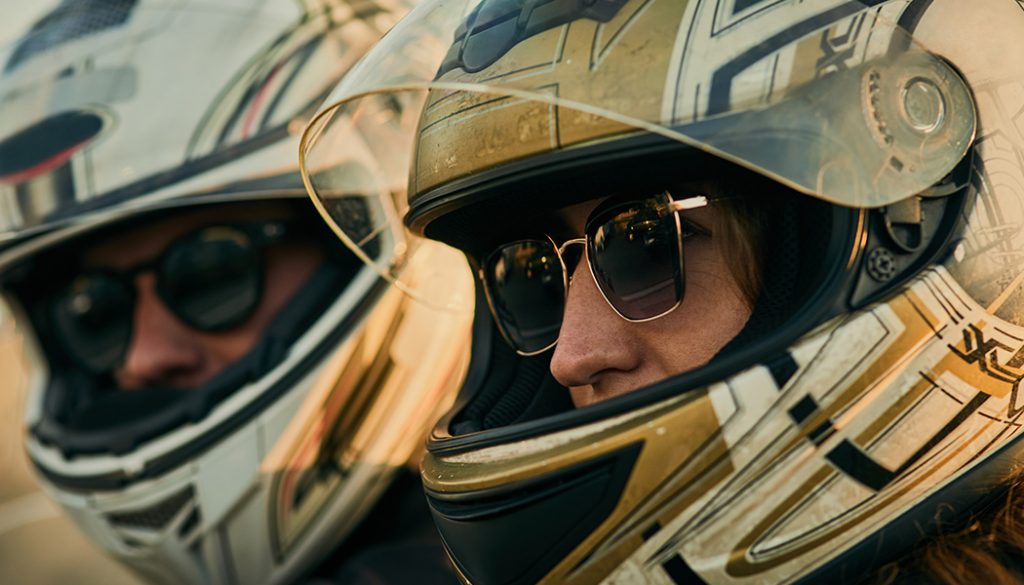

I think we’d all agree that the brain is a relatively important organ, especially when you’re a rider. Cognitive abilities are necessary for making decisions with life-changing consequences, and that’s way more important when you’re on two wheels. It’s mind-boggling that cranial protection isn’t mandatory for motorcyclist everywhere in the world, especially in the safe bubble of the US of A. But smart riders always wear a helmet. So here’s how to pick a motorcycle helmet.
Not just any helmet will do, though. Which helmet you should choose depends heavily on how and where you ride. For instance, wearing a half shell is plain stupid if you’re riding a Gixxer. You’ll also look like a dweeb if you wear a dual-sport helmet on a Vespa.
Anyway, let’s get to our guide on how to pick a motorcycle helmet.
No ifs, ands, or buts. Never take chances with an uncertified helmet. Not only can you be ticketed in some areas for wearing a helmet that doesn’t meet the right criteria, but you’re putting your life at risk.
First, the minimum standard: DOT approval. If it doesn’t have a DOT sticker on it, put it down and back away. That’s a helmet that could leave your noggin in worse condition than shaking a carton of eggs. Knock-off cheapie overseas helmets are often not certified in North America, and for good reason. the
There are higher manufacturing standards too, such as Snell M2015. They test to a higher standard, which is probably something you’re interested in when learning how to pick a motorcycle helmet. You’ll pay a premium for these helmets but keeping your skull intact is worth it, no?
You can lump any helmet on the market into five designs. Each has its own merits, but not every helmet will be suited to you or your application.
Like it says, it covers your whole face. You’ll have a visor that opens and closes, along with a face vent and sometimes venting on the back or top of the helmet as well.
Usually open-faced, dual sport helmets are increasingly popular in certain segments. The eye opening cuts further back for better side visibility. A visor is integrated but the protection is all there with the rigid section across the jaw area.
For the minimalist, half shells are attractive. They offer the least protection because of the limited coverage, but it’s better than nothing. And they’re hugely improved today over the half shells from even a decade ago.
For those with a huge head, modular helmets can be the way to go. The full-face protection is there but the face section hinges at the temples and swings upward. Not only is it easier to put on for some cranially-blessed folk, but there are more options including a visor, tinted glasses integrated, and some have intercoms.
The old-school helmet look is in these days. Open face helmets protect the head very well while keeping your face exposed to the wind…and the bugs. It’s a rudimentary design, but still effective.
Related Search Topics (Ads)
What’s the most important thing about a helmet for riding a motorcycle? If you said, “the coolness factor”, you’d be right. Well, aside from safety anyway. Your helmet design has to fit with the bike you ride.
If you ride a sport bike, you only have two choices from this list of five: full face or modular. And sometimes, modular still looks goofy. Plus, the others aren’t functional, but we’ll talk about that in a minute.
For cruisers, options are a little more open. You could choose a classy half shell and wear sunglasses, a modular helmet, or even a full face helmet. The more spartan your motorcycle, the closer you’ll lean to the next category.
And that’s choppers and customs. Look, with this style of bike, wearing anything on your dome other than a half shell just seems wrong. But if you want extra protection, get a full face and have it painted in a matching theme to your bike.
Style wise, the dual sport helmet should only be paired with a dual sport motorcycle. That’s the best fit. In a pinch, a full face or modular helmet could also do the trick.
Café racers rejoice – there’s a reason to pull out an open face helmet once again. It’s really the only place that an open face helmet is in style other than the scooter scene.
Helmets have to be functional for how you ride. In fact, anything else could be considered unsafe, even if it’s just due to being a distraction.
If you aren’t doing any death-defying riding – aka. behaving like a sane person – then any of the five helmet choices are fine. That’s why wearing a half shell or open face helmet is an acceptable idea in any situation.
If there’s even an off chance you’ll be redlining your crotch rocket once, toss aside the idea of anything but full coverage when looking at how to pick a motorcycle helmet. Two options only: full face and modular. With a streamlined design and a face shield to protect against bugs and dirt hitting your face at a hundred miles per hour, they’re best suited to speed.
In case you fall off your bike and bash your face against the ground, a dual sport helmet is the best protection. There’s more space in the jaw area to prevent impact from rearranging your appearance. A full face helmet or modular helmet are also acceptable.
Of course, you wouldn’t ride again with a damaged helmet, would you? If it’s been cracked or scuffed in a crash, replace it. You don’t know if or how it has been compromised.
Also, once you’ve learned how to pick a motorcycle helmet, you’re not done. H should be replaced every five years. Honestly, the sweaty stench in your bucket will probably be enough to make you change it well before that point.
Related Search Topics (Ads)